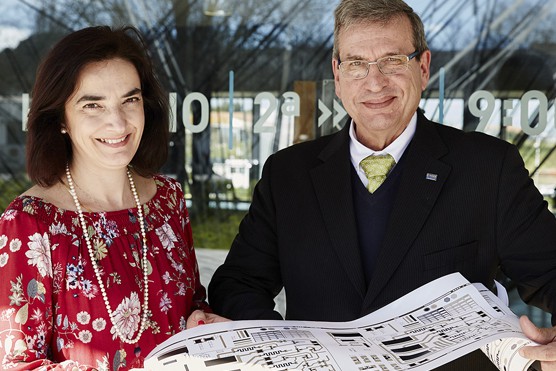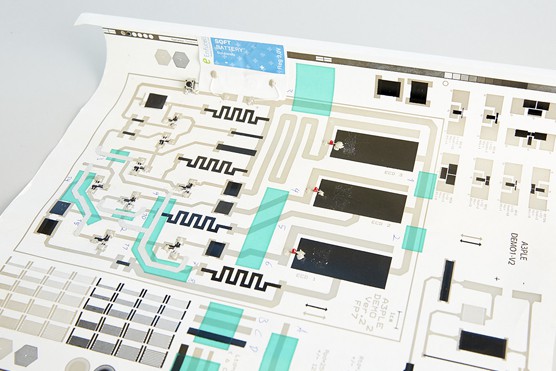
Elvira Fortunato
Education
1991 MSc in semiconductor materials New University of Lisbon
1995 PhD in microelectronics and optoelectronics, as above
Career
1996 Demonstrator in Material Science Dept, New University of Lisbon
1998 Director, Materials Research Centre (CENIMAT)
2012 Full Professor, Material Science Dept, New University of Lisbon
Rodrigo Martins
Education
1977 MSc in Materials Science, University of Dundee
1982 PhD in energy conservation in semiconductors, New University of Lisbon
Career
Prof Martins is head of materials science at the New University of Lisbon,
President of the Senate of the European Materials Research Society, and a member of the Advisory Boards of Horizon 2020 in Advanced Materials, Nanotechnology and Biotechnology
Using paper as both a structural and functional material in electronic components will lead to new generations of recyclable smart packaging, medical devices and other products
The price of electronics has been dropping steadily for decades. What were one luxury high-tech articles are now commonplace, and microprocessors are being incorporated into ever-more numerous appliances and devices as the prefix ‘Smart-‘ becomes almost oxymoronic, for both consumer devices and increasingly, industrial machinery and tools.
But there is still a choke-point, because the price of making electronics as they are can’t go below a certain level. The silicon and germanium-based materials of which transistors and their derivative products, microchips, are made have an associated cost, both in financial and environmental terms. No matter what economies of scale are employed by heir manufacturers, they still require high-temperature processing and the use of chemicals which must be removed from factory waste or otherwise treated to render them harmless before discharge from the factory. No matter how cheap thy become, electronic can’t be regarded as disposable; and although it’s possible and desirable to recover high-value materials from scrapped electronics, they can hardly be regarded as fully recyclable, either.
But that might be about to change at least for some categories of electronics – an entirely new category, in fact, where the inorganic semiconductor devices have been replaced with a familiar, but most surprising material: paper.
Professor Elvira Fortunato, a materials scientist and engineer at the New University of Lisbon in Portugal specialising in transparent electronics, realised early this decade that silicon wasn’t necessarily needed in transistors. “There are three types of material needed,” she explained at the recent European Patent Office Inventor’s Award event in her home town. “You need conductors: the metal leads, wires and contacts you see on see on electronic components. You need semiconductors, of course, to perform the actual functions of the component. But you also need insulators, sometimes called dielectrics, which are vital for the function of the components.”
In many transistors, the dielectric is a thin layer of pure silicon, sandwiched between layers of silicon that have been ‘doped’ with very small amounts of other atoms that have more or fewer electrons available in their outermost layers. Where there are extra electrons, these float around the atomic lattice structure of the silicon and can be moved by an electric current. Where there are fewer, they leave gaps that do not weaken the structure but provide another mechanism for charge to travel through the material. Manipulating the distribution and flow of free electrons and gaps across the insulating layer is the key to how transistors- and, by extension, all electronics – work. The insulating layer acts as a block to electron flow, and can also store electrons; moreover, differences in charge on either side of the insulating layer influence the behaviour of the other layers through electrostatic attraction and repulsion.

Fortunato’s key realisation was that the insulator and semiconductors don’t have to be silicon. Initially, she and her husband, Rodrigo Martins, a fellow material specialist at the same institution were trying to embed electronics onto paper as a flexible support material. But, she reasoned, maybe the insulator were a biopolymer like cellulose? This led to the theory that the paper itself could be made part of the support structure of the component. And could other semiconductors – for example, oxides of electron-rich transition metals – work across a layer of paper in the same way that doped silicon work across the pure material?
“To be frank, I though that there was a very low probability that it would work,” Fortunato said. “it just seemed too simple.” But working with her husband, Rodrigo Martins, a fellow material specialist at the same institution, Fortunato asked one of her graduate students to test the idea out with a simple transistor design. “We were very happy to find that a soon as a voltage was applied, current flowed exactly as it would in a conventional transistor,” she said.
The next stage of the research was to use the metal oxide semiconductors as ink. Suspending nanoparticles of gallium, indium or zinc in a liquid medium was simple, and the team adapted an inkjet printer to use these inks. The paper is coated with a nano-thin layer of alumunium, which acts as a conductor linking separate components, than the semiconductor components are simply printed onto both sides of the paper. “We also need the aluminium to help dissipate heat generated as current flows through the semiconductor layers,’ Fortunato added. “This is very important in all electronics, but conventional electronics have some ability to dissipate heat; our materials cannot dissipate heat on their own.” Printing accuracy is vital, Martins said, so that the components on each side line up properly, but a very wide variety of components can be printed, including photoelectric cells to power the electronics, sensors for organic molecules, and even display components like alphanumerics, where a current makes a transparent layer of ink opaque. Systems as complex as RFID circuits are printable, he said, all with paper as the insulating component in the system.
One of the great successes of electronics is miniaturisation, which allows a very large number of transistors to be put onto single chip – this is the basis of microprocessors. Something similar is possible with paper electronics, Matins said. “If you coat the semiconductor inks onto single cellulose fibres, and cross them over each other, you make a transistor where they cross, and that will only be a couple of nanometres across. Such precision is very possible,” he said. “and that allows you to construct very complex electronic circuits.”
However, even Fortunato and Martins admit the limitations of their technique. A well as the heat dissipation issue, conventional silicon-and germanium-based electronics are more efficient and faster than those based o paper transistors. “We can’t replace silicon and don’t intend to; these systems will work alongside,” Martins said. “Where they have a definite advantage is in applications where you need very large numbers.” The materials are all cheap and readily-available, and processing requires well-known and understood techniques that do not need high temperatures, vacuum, ultra-clean environments or hazardous gases. “To recycle silicon, you need temperatures in excess of 120°C; with paper electronics, you can just burn it when you’re done,” he added.
The pair believe hat food packaging is likely to be the biggest initial application of the technology. “You can incorporate sensors in the packaging to measure the concentration of gases inside the package that indicate microbial activity, and that will change a display element to indicate the contents are no longer safe,’ Fortunato said. “Current use-by information is effectively a guess; this will come from unequivocal measurement.” Printed radio receivers, powered by solar cells that function under artificial light, could also trigger changes in price displays; similar techniques could be used to print tickets for flights or trains that update themselves when new information becomes available; further ahead, moving graphics on newspapers might be possible. Whether we’d get to a technological version of the magical moving photos in Harry Potter films is another matter.




JLR teams with Allye Energy on portable battery storage
This illustrates the lengths required to operate electric vehicles in some circumstances. It is just as well few electric Range Rovers will go off...